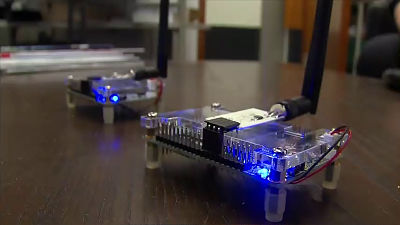"FreeSense" technology which distinguishes people from "physical features" and "movement" only by disturbance of Wi-Fi radio waves

Everything is connected to the netInternet of things(IoT) world is about to come. In such IoT world there are possibilities that various new services can be born if it can recognize who the surrounding users are who connected to the net, but how to use that disturbance of Wi - Fi, that person The technology to scan who is who is invented.
[1608.03430] FreeSense: Indoor Human Identification with WiFi Signals
http://arxiv.org/abs/1608.03430
WiFi Signals Can ID Individuals by Body Shape | Motherboard
http://motherboard.vice.com/read/wifi-signals-can-id-individuals-by-body-shape
Devices connected to the Internet by IoT by 2020 are expected to reach tens of billions of dollars, but one of the very important design philosophies for IoT terminals expected to blend into daily living is "seamless To integrate devices into one another "is mentioned. From the viewpoint of realizing this seamless integration, it is studied that "How to recognize the surrounding people related to the device?" Is being studied.

ByITU Pictures
For example, if the terminal of IoT can individually recognize the surrounding people, the IoT air conditioner lowers the room temperature when a very hot person enters the room, and the audio equipment of IoT matches the taste of the person in the room It makes it possible to automatically play music.
There are a number of approaches to let people identify people in the past, and representative technologies are face recognition, fingerprint authentication technology, embedded RFID chips. However, face recognition technology and fingerprint authentication technology had problems of privacy, RFID chips needed to embed chips in everything, so none of them was lacking in decision-making.
Meanwhile, researchers at the Northwestern Institute of Technology in the United States will use the radio waves of Wi - Fi to identify people around themFreeSense"We developed a technology called" The mechanism of FreeSense is to identify people from surrounding people shielding Wi - Fi radio waves. Wi-Fi radio waves are affected when people take action, but that people can be identified from the influence of this radio wave. Specifically, he seems to recognize a person not only from "physical features" such as the height of a person but also from "movement" peculiar to that person.
In the demonstration experiment of FreeSense, we asked the nine volunteers to spend time in a room that assumed 30 square meters of smart home with furniture and so on, and let the FreeSense system recognize and grasp the characteristics of the person. As a result, when there were only two people in the room, it was 95% probability that we could identify the person. Accuracy was lower as the number of indoor people increased, but we succeeded in identifying people with accuracy of 75% as a whole. In the experiment, if the number of people is 2 to 6, we have successfully identified with an accuracy of 88%.

FreeSense is considered to be superior to face authentication in terms of privacy, because it acquires only the information of the figure and movement of a person to the last while keeping high recognition accuracy. Since we can recognize people with extremely high precision if we are 6 people or less at the present time, we believe that in homes of nuclear families in modern society, it is practical as a person recognition technology in smart homes. The research team at Northwestern Institute of Technology will further increase the accuracy of FreeSense by examining how the recognition accuracy will be affected if the distance between the receiver and the transmitter of the wireless LAN is increased.
Related Posts:







